Author: LTP Research
Within a price range of only 0.1%, Binance's liquidity performance always remains at the forefront. Once the price range exceeds 0.3%, Binance's liquidity for Bitcoin trading pairs becomes more volatile, while Kraken's liquidity performance is relatively high.
Introducing LTP Liquidity Score: A Liquidity Calculation Method Based on Order Book Depth
Report Summary
In the trading world, liquidity issues are critical for any type of investor, trader, or exchange. This report aims to introduce and analyze the liquidity changes of various currencies in centralized cryptocurrency exchanges based on order book depth data, and then derive the changing trend of the exchange's overall liquidity for investors' reference.
As a leading prime brokerage service provider in the cryptocurrency industry, LTP uses an independently developed liquidity scoring method to comprehensively evaluate the liquidity performance of exchanges. By comparing the order book depth data of more than 13 cryptocurrency pairs on 12 major exchanges for more than 6 months, this report draws the following main conclusions:
The top four exchanges with the best liquidity are Binance, Kraken, Coinbase and OKX, and their ranking can remain relatively stable over an observation period of more than 6 months.
Since March 2024, the liquidity performance of Gate and KuCoin has gradually increased. Bitfinex's liquidity has shown higher volatility.
Bitcoin liquidity performance: Only within a price range of 0.1%, Binance's liquidity performance has always maintained a leading position. Once the price range exceeds 0.3%, Binance's Bitcoin trading pair liquidity becomes more volatile, while Kraken's liquidity performance is relatively high.
Ethereum liquidity performance: Compared with Bitcoin, Ethereum's liquidity across all exchanges is more volatile at five price range levels. In contrast, Binance's Ethereum liquidity score only becomes more stable when the price range exceeds 0.3%.
By observing the LTP liquidity index, the market's overall LLI liquidity index has steadily increased from January to June 2024, with five liquidity peaks. The first three occurred in March, when the Bitcoin price broke through the previous high, and the last two occurred in early June.
Brief Introduction to the Concept of Liquidity
What does liquidity mean in finance?
In financial markets, liquidity refers to the ease with which an asset or security can be converted into cash without significantly affecting its price.
Where “without significantly affecting its price” means:
The greater the impact of a transaction on the market price, the lower the liquidity of the asset.
Example:
Case 2: Bob buys $100,000 of asset B, causing the price to rise by 2%.
In both cases, we can see that asset A is more liquid than asset B. Because for the same investment amount, the price of asset A rises less, which means that the amount of the investment has less impact on the market price, so it is more liquid.
And "Ease of conversion to cash" means:
The more difficult it is to convert an asset into cash, the less liquid the asset is.
For example, in general:
Therefore, gold has better liquidity than real estate.
Crypto Exchange Liquidity
Centralized Exchange Liquidity (CEX)

Source: binance.com
In the crypto industry, almost every centralized exchange uses an order book to list all pending orders.
Generally speaking, the more buy and sell orders included in the order book, the better the liquidity of the trading asset.
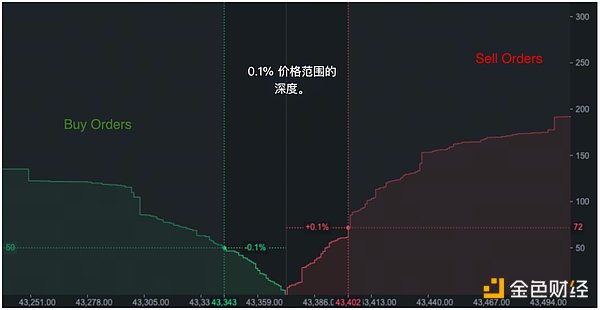
Source: binance.com
The above picture is a snapshot of the depth view of the Bitcoin order book. On the left are the seller's pending orders, and on the right are the seller's pending orders. Investors can view the total number of Bitcoins available for buyers and sellers within a specific price range. As shown in the figure, the 0.1% price range shows that the buyer and seller have 50 and 72 Bitcoins available, respectively.
By comparing the depth of the order book, whether in terms of Bitcoin or US dollars, investors can identify which exchange provides the best liquidity.
Schematic diagram of the liquidity score calculation methodology
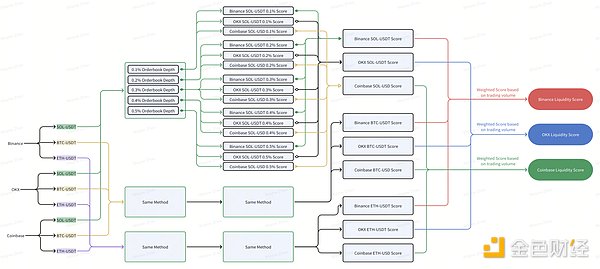
Liquidity of decentralized exchanges (DEX)
Decentralized exchanges (DEXs), as the backbone protocols and the foundation of liquidity in the decentralized finance (DeFi) track, rely on a trading mechanism called an automated market maker (AMM).
Due to the limited settlement speed of Ethereum, most DEXs do not rely on traditional buy and sell orders, so they do not require an order book, which is different from traditional exchanges. DEX traders trade directly with a liquidity pool consisting of two tokens*. The price of each token in the pool is determined by a fixed mathematical formula. The most classic DEX Uniswap uses the formula of constant product: x * y = k, that is, in the absence of new liquidity, no matter how users trade, the product of the two currencies in the pool remains unchanged.
In DEX, there is a role of liquidity provider (LP), who is responsible for providing both currencies in the pool for trading at the same time, thereby earning handling fees. As the popularity of the currency increases, there are more incentives for LP, more tokens are added to the pool, the total locked amount TVL will also increase, and the liquidity of the pool will increase.
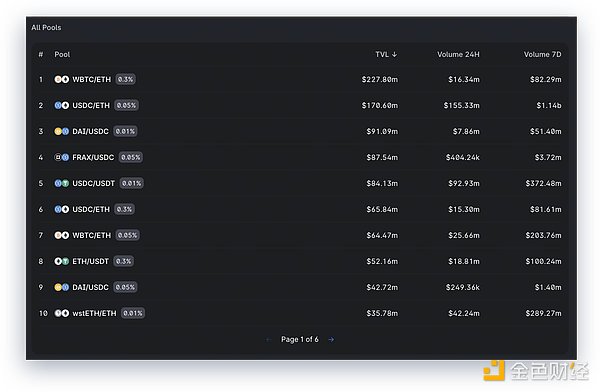
Source: https://info.uniswap.org/
Tokens with higher total locked value (TVL) in the liquidity pool have better liquidity in decentralized exchanges.
LTP Liquidity Score
What is LTP Liquidity Score
In order to solve the problem that the trading volume cannot accurately reflect the liquidity situation due to the exchange's brushing, LTP independently developed a novel exchange ranking method that relies entirely on the analysis of objective order book data without considering subjective or other confusing factors. Order book data provides valuable insights into exchange trading activity, market depth, and participant behavior. This alternative ranking method is not intended to replace existing volume-based rankings, but rather to serve as a complementary tool. By examining order book data, we can better understand liquidity differences between exchanges and use liquidity as a metric to evaluate exchange performance. In the following report, we attempt to:
Explain the methodology used to calculate liquidity scores.
Compare the liquidity and ranking of 12 centralized exchanges.
Analyze liquidity data for major high-volume tokens.
Introduce and explain what the LTP Liquidity Index is.
How are exchange liquidity scores calculated?
Collect order book snapshot data: Get order book data for the same base token trading pair from different exchanges. For example, BTCUSDT from Binance, BTC-USD from Coinbase, XBTUSD from Kraken, and tBTCUSD from Bitfinex. This data will include the bid and ask prices and corresponding quantities at each price level.
Calculate the depth of the price range: Determine the depth of the order book at a specific price range level. For example, calculate the depth of the 0.1%, 0.2%, 0.3%, 0.4%, and 0.5% price ranges. This requires summing the number of orders within a specific percentage of the market price.
Calculate the liquidity score for each trading pair: Compare the depth of different trading pairs at each price range. Calculate the liquidity score for each trading pair based on the relative depth. The greater the depth, the higher the liquidity score.
Aggregate liquidity score: Combine the liquidity scores obtained for each trading pair at different price ranges (for example, 0.1% to 0.5%). Calculate a weighted average score by assigning appropriate weights to each level of price range and liquidity score.
Calculate liquidity scores for multiple trading pairs: Extend the same method to calculate liquidity scores for more trading pairs and different base tokens. Gather order book data for the required trading pairs and repeat steps 2 to 4.
Calculate liquidity scores on an exchange-by-exchange basis: Finally, calculate the total liquidity score for the exchange by aggregating all the different trading pairs on each exchange. Weight the liquidity score based on the 24-hour trading volume of each trading pair. Trading pairs with larger trading volumes will have a greater impact on the overall exchange liquidity score.
On the next page, we present the above process in a diagram. If you are interested in a detailed explanation of the methodology, please visit: Exchange Liquidity Ranking Methodology.
Currency and Trading Pair Selection
For spot trading, an exchange offers trading options for multiple currencies, and for the same base currency, it generally also offers trading options for multiple quote currencies. Therefore, the liquidity of an exchange is very fragmented.
To analyze the liquidity of an exchange more realistically, we first check its most liquid trading pairs.
Ideally, all trading pairs should be considered, but due to specific constraints, we choose a limited number of trading pairs that account for more than 70% of the total trading volume.
When comparing exchanges, we target pairs with the same base coin (e.g., BTC-USDT vs. BTC-USD).
We first analyze the order book data for the selected pairs. The score for a pair is calculated by comparing different pairs with the same base coin on the same exchange.
The total liquidity score for an exchange is a volume-weighted score for the pair.
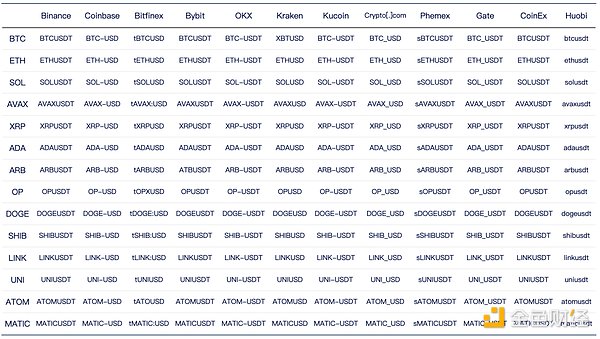
Exchange Liquidity Ranking
Exchange Liquidity Score
As the world's largest centralized crypto exchange, Binance remains the most liquid market, with an average liquidity score of 95.99 over the past six months, with only a large fluctuation in early March. Kraken is second, and it now ranks second in the liquidity ranking with an average score of 86.85.
The top four exchanges with the best liquidity are Binance, Kraken, Coinbase, and OKX, and their rankings are relatively stable over time.
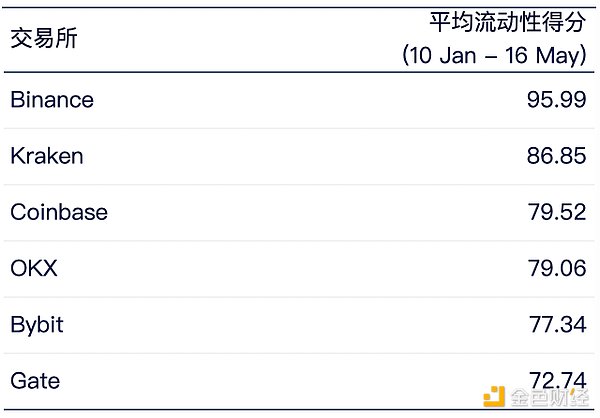
Source: LTP Research
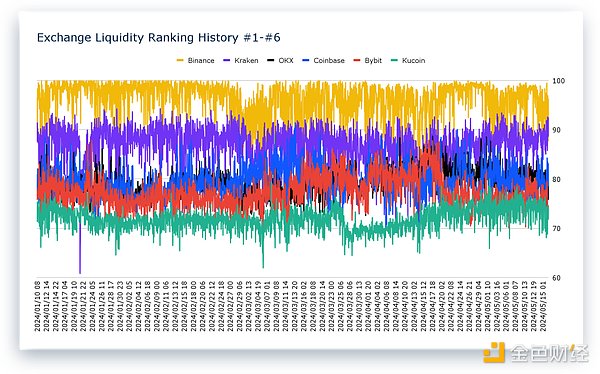
Source: LTP Research
Among the remaining 6 exchanges, Gate.io is currently ranked 7th with an average score of 71.87. The liquidity score trend of Gate.io has risen significantly since March 20, exceeding 80 points for a period of one month, and then fell back. Bitfinex followed closely behind, with the highest volatility among all exchanges.
From the trend, the liquidity performance of Gate and KuCoin has gradually improved since March 2024. There is no obvious change in Phemex, Huobi, Crypto.com and Coinex.
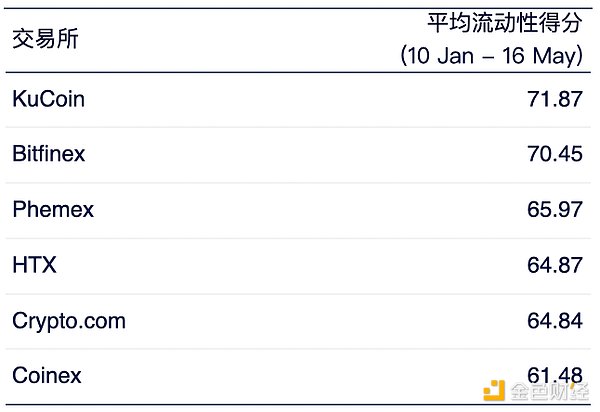
Source: LTP Research
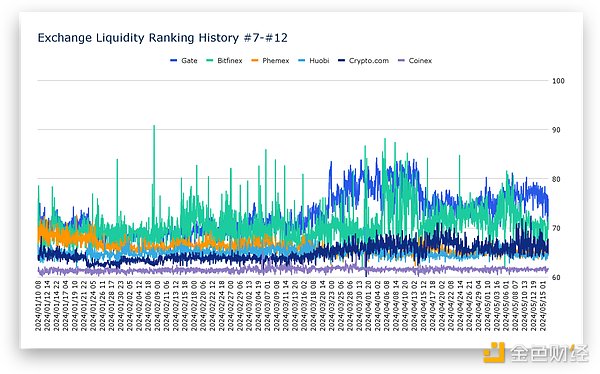
Source: LTP Research
Currency Liquidity
Bitcoin Liquidity
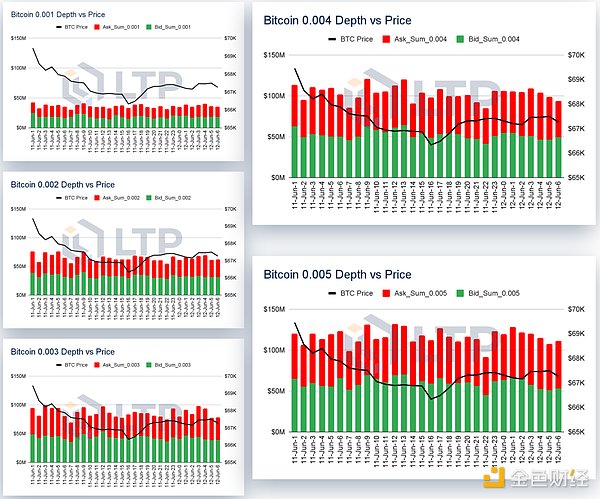
Source: LTP Research
By aggregating Bitcoin order books from 12 centralized exchanges and classifying them into buy orders and sell orders, we observed the order book depth performance of Bitcoin in five price ranges from 0.1% to 0.5%.
In order to enlarge the granularity, we selected the depth change data of Bitcoin within 30 hours between June 11 and 12, 2024.
It is not difficult to see that within the price range of 0.1%, the average Bitcoin depth does not exceed 50 million US dollars. At the 0.3% level, it only reaches $100 million. The difference between the 0.4% and 0.5% intervals is not large.
Bitcoin market liquidity rankings of various exchanges
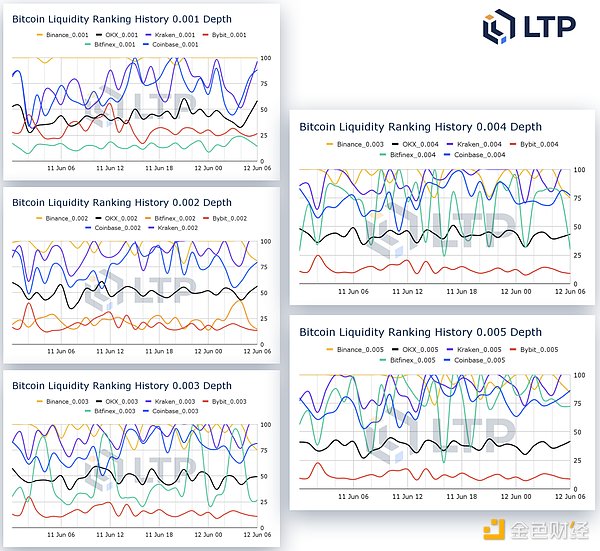
Source: LTP Research
Binance is the most liquid exchange in Bitcoin's trading orders. Especially near the order book that is very close to the market price, Binance's liquidity performance is very stable and always ranks first. From this point of view, for retail traders, Binance can always complete orders at the best price.
However, when considering orders that are far from the market price, Binance's advantage is not so obvious. In the price range of several hundred points, OKX and Kraken often occupy the first position.
When the price range extends to 0.4%, Kraken can maintain the first position most of the time. Kraken's ability to rank first in such a price range is mainly closely related to its ability to provide free Bitcoin transaction fees.
Ethereum's liquidity
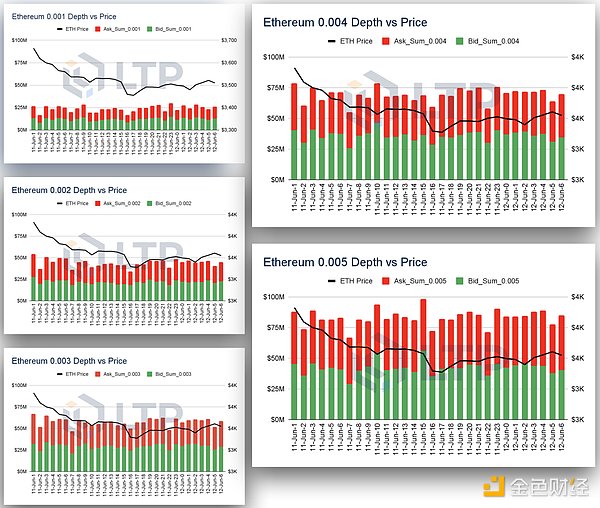
Source: LTP Research
Similar to Bitcoin, the data on the left captures the depth changes of Ethereum ETH within 30 hours from June 11 to 12, 2024.
The depth distribution of ETH is more concentrated at the level of 0.3% to 0.4%. At the 0.1% level, the depth is less than $25 million; at the 0.3% level, the depth is more than $50 million; at the 0.4% level, the depth is more than $75 million. However, there is no significant increase at the 0.5% level.
According to the data during this period, the buy and sell orders of Ethereum ETH always maintain a 1:1 ratio.
Liquidity ranking of exchanges in the Ethereum market
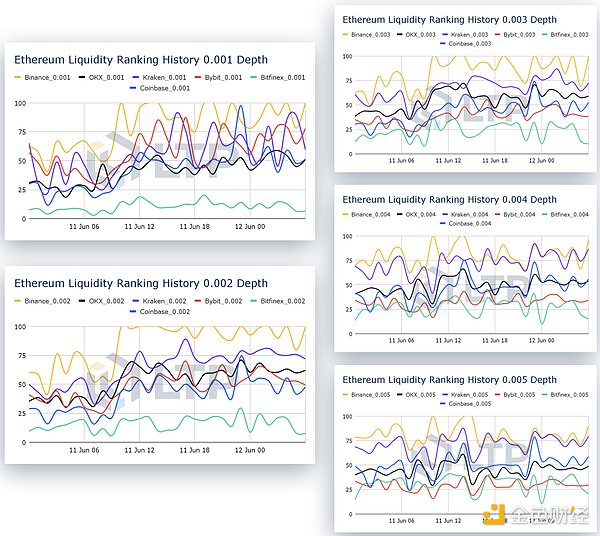
Source: LTP Research
The liquidity changes of Ethereum ETH are more volatile than BTC in 12 exchanges. Although Binance still ranks first, its score has fluctuated by more than 50% within the observed 30-hour interval.
In particular, in the early morning hours of June 11, except for the 0.5% price interval, the liquidity score of Ethereum ETH in all other intervals did not exceed 75 points. It was not until after 6am that Binance and other exchanges showed improvement.
OKX and Bybit have the potential to catch up with Binance in Ethereum ETH liquidity performance. Especially in the 0.1% price range, their liquidity scores are very close to Binance.
LTP Liquidity Index LLI
What is the LTP Liquidity Index?
LTP Liquidity Index is an indicator of the overall liquidity of the cryptocurrency market, derived from the BTC and ETH weighted order book depth data of the three major centralized exchanges, Binance, Coinbase and Kraken. It intuitively helps investors understand how the overall market liquidity changes over time and BTC price changes. Next, let's take a look at the basic principles of the LTP Liquidity Index.
How is the LTP Liquidity Index (LLI) calculated?
We extract bid and ask order depth data from the BTC order books of Binance, Coinbase, and Kraken, and divide the depth into five price intervals, from 0.1% to 0.5%. Next, we calculate the total depth for each price interval.
We then assign weights to each price interval: 0.1% is 30%, 0.2% is 25%, 0.3% is 20%, 0.4% is 15%, and 0.5% is 10%.
We use these weights to calculate the weighted depth of each exchange, price interval by price interval, on a daily basis. Then, we add the weighted depths of the three exchanges to get the daily weighted depth of BTC.
We set the depth data of the starting day as the base value of 1,000. By comparing the remaining depth data with the starting day data, we start to change from 1,000 points based on its percentage to get the BTC liquidity index.
Using the same method, we calculate the liquidity index of ETH. Next, we combine the BTC liquidity index and the ETH liquidity index, with BTC accounting for 75% of the weight and ETH accounting for 25% of the weight, to obtain the LTP liquidity index.
Currently, the LTP liquidity index only introduces two mainstream crypto assets, BTC and ETH, as targets. In the future, more Crypto targets will be introduced according to market value, and they will be equipped with corresponding weights.

LTP Liquidity Index (LLI)
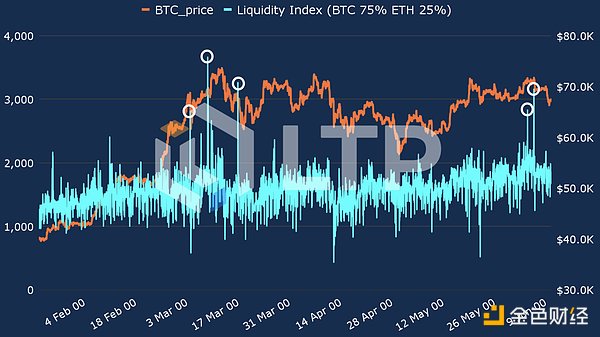
Source: LTP Research
The upper chart is based on hourly changes, clearly showing the period from January 2024 to mid-June 2024 The relationship between the LTP Liquidity Index (LLI) and Bitcoin price.
From the chart, we can see that over the past six months, the liquidity index has gradually increased from the starting point of 1,000 points, with a standard deviation of about 250 points.
As of June 13, 2024, the liquidity index has risen to 1,748 points. During the Bitcoin historical high (ATH), there were several outliers exceeding 3,000 points, which indicates that market liquidity has surged in the short term and is an important signal for price increases. It is worth noting that this signal also appeared in early June.
BTC Liquidity Index
When we examine the liquidity index of BTC alone, we can see that the two liquidity peaks mentioned above in March and June both came from BTC, with peaks close to 4,000 points.
On the contrary, BTC's liquidity only had two severe downward spikes in this range, which occurred in mid-April and late May respectively.
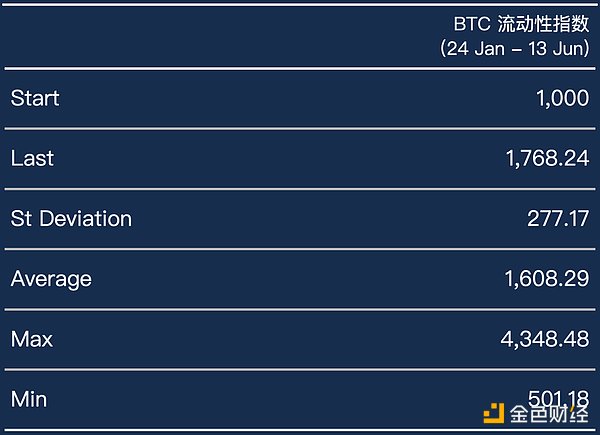
Source: LTP Research
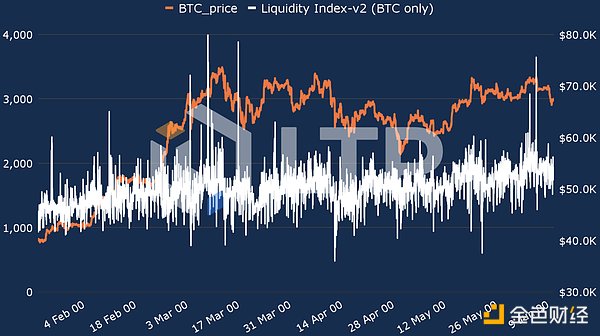
Source: LTP Research
Deep data of Bitcoin order book
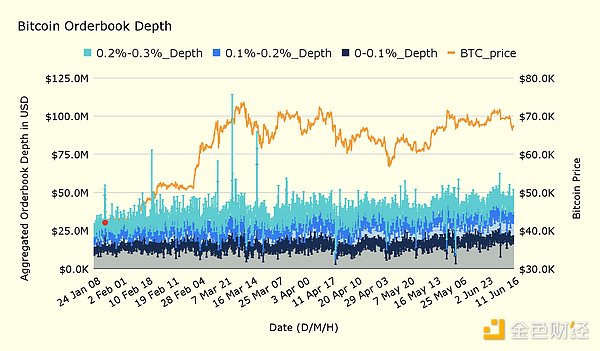
Source: LTP Research
This figure shows the BTC order book layered depth data of three exchanges.
Although the BTC order book depth data is divided into five gears (0-0.1%, 0.1%-0.2%, 0.2%-0.3%, 0.3%-0.4%, 0.4%-0.5%) in actual calculation, for the sake of clarity, the figure only shows the first three gears.
It is not difficult to see that the liquidity peak of Bitcoin in March mainly appeared in the range of 0.2%-0.3%.
ETH Liquidity Index
As for Ethereum ETH's liquidity index, it peaked at more than 3,000 points only once during its all-time high in mid-March, and there was no such peak in June. On the contrary, the ETH liquidity index fell below 500 points at three points: once before the peak in March, once in mid-April, and once after the Ethereum ETF was approved at the end of May.
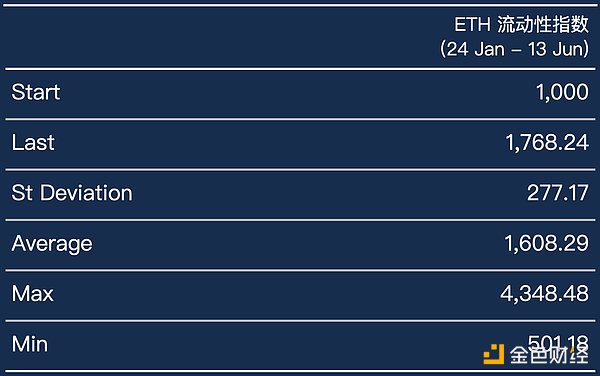
Source: LTP Research
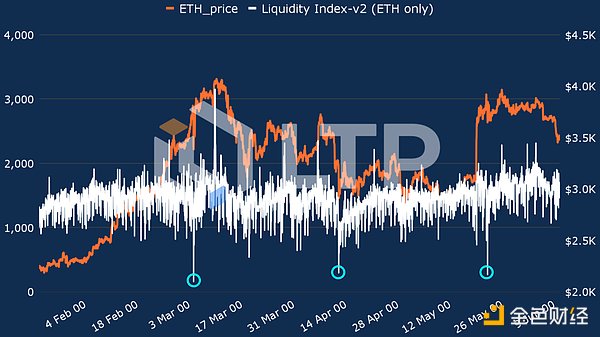
Source: LTP Research
Deep data of Bitcoin order book
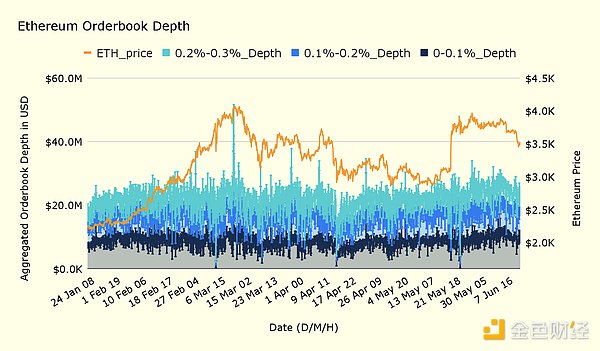
Source: LTP Research
This figure shows the depth data of the ETH order book of three exchanges, Binance, Kraken, and Coinbase.
Similarly, although the actual calculation divides the ETH order book depth data into five levels, the figure only shows the first three levels, namely 0-0.1% until 0.2%-0.3%.
It is obvious that the three liquidity troughs in the past six months all occurred in the range of 0.2%-0.3%. Each time the liquidity dropped sharply, the overall liquidity level fell below $10 million.
Summary
We started with the basic concept of liquidity and introduced investors to liquidity in traditional finance and how to understand it. Next, we explained how the order book depth of cryptocurrency exchanges affects liquidity and briefly introduced the concept of liquidity in decentralized exchanges.
Then, we introduced how LTP uses the depth data of different price ranges in the exchange order book to calculate the LTP liquidity score for each exchange and cryptocurrency. After obtaining long-term data, we ranked the liquidity of 12 target centralized exchanges.
From the liquidity score data, it can be seen that the top four exchanges with the best liquidity are Binance, Kraken, Coinbase and OKX, and their ranking can remain relatively stable over an observation period of more than 6 months. Since March 2024, the liquidity performance of Gate and KuCoin has a gradually increasing trend. Bitfinex's liquidity shows higher volatility.
In addition, we compared the liquidity performance of BTC and ETH trading pairs on various exchanges over a period of about six months and observed that Binance did not always remain in the top position.
Only within a price range of 0.1%, Binance's liquidity performance always maintained its leading position. Once the price range exceeded 0.3%, Binance's liquidity for Bitcoin trading pairs became more volatile, while Kraken's liquidity performance was relatively high.
Finally, to assess the volatility of overall market liquidity, we introduced the LTP liquidity index. We observed a gradual upward trend in market liquidity over the past six months.
It should be noted that the raw data for this report comes from the public exchange order book API, and we only used the main trading pairs of 12 mainstream exchanges, so the coverage is not comprehensive. In future versions, we will include more trading pairs to make the scoring and index more effective.
 JinseFinance
JinseFinance



























